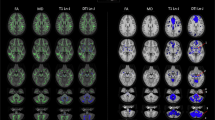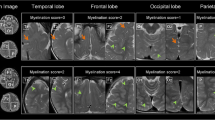Abstract
Objectives
To provide an initial assessment of white matter (WM) integrity with diffusion tensor imaging (DTI) and the accompanying volumetric changes in WM and grey matter (GM) through volumetric analyses of young children with Down’s syndrome (DS).
Methods
Ten children with DS and eight healthy control subjects were included in the study. Tract-based spatial statistics (TBSS) were used in the DTI study for whole-brain voxelwise analysis of fractional anisotropy (FA) and mean diffusivity (MD) of WM. Volumetric analyses were performed with an automated segmentation method to obtain regional measurements of cortical volumes.
Results
Children with DS showed significantly reduced FA in association tracts of the fronto-temporo-occipital regions as well as the corpus callosum (CC) and anterior limb of the internal capsule (p < 0.05). Volumetric reductions included total cortical GM, cerebellar GM and WM volume, basal ganglia, thalamus, brainstem and CC in DS compared with controls (p < 0.05).
Conclusion
These preliminary results suggest that DTI and volumetric analyses may reflect the earliest complementary changes of the neurodevelopmental delay in children with DS and can serve as surrogate biomarkers of the specific elements of WM and GM integrity for cognitive development.
Key Points
• DS is the most common genetic cause of intellectual disability.
• WM and GM structural alterations represent the neurological features of DS.
• DTI may identify the earliest aging process changes.
• DTI-volumetric analyses can serve as surrogate biomarkers of neurodevelopment in DS.




Similar content being viewed by others
References
Parker SE et al (2010) Updated national birth prevalence estimates for selected birth defects in the United States, 2004–2006. Birth Defects Res Part A: Clin Mol Teratol 88:1008–1016
Martin GE et al (2009) Language characteristics of individuals with Down syndrome. Top Lang Disord 29:112
Silverman W (2007) Down syndrome: cognitive phenotype. Ment Retard Dev Disabil Res Rev 13:228–236
Jarrold C, Baddeley AD, Hewes AK (2000) Verbal short‐term memory deficits in Down syndrome: a consequence of problems in rehearsal? J Child Psychol Psychiatry 41:233–244
Dodd B (1975) Recognition and reproduction of words by down’s syndrome and non-down’s syndrome retarded children. Am J Ment Defic 80:306–311
Fowler A, Gelman R, Gleitman LR (1994) The course of language learning in children with Down syndrome. In: Tager-Flusberg H (ed) Constraints on language acquisition studies of atypical children. NJ Lawrence Erlbaum Associates, Hillsdale
Baddeley A, Jarrold C (2007) Working memory and Down syndrome. J Intellect Disabil Res 51:925–931
Carr J (1970) Mental and motor development in young mongol children*. J Intellect Disabil Res 14:205–220
Engidawork E, Lubec G (2003) Molecular changes in fetal Down syndrome brain. J Neurochem 84:895–904
Guihard-Costa A-M et al (2006) Biometry of face and brain in fetuses with trisomy 21. Pediatr Res 59:33–38
Jernigan TL, Bellugi U (1990) Anomalous brain morphology on magnetic resonance images in Williams syndrome and Down syndrome. Arch Neurol 47:529–533
Pinter J et al (2001) Amygdala and hippocampal volumes in children with Down syndrome: a high-resolution MRI study. Neurology 56:972–974
Kates WR et al (2002) Cerebral growth in fragile X syndrome: review and comparison with Down syndrome. Microsc Res Tech 57:159–167
Śmigielska-Kuzia J et al (2011) A volumetric magnetic resonance imaging study of brain structures in children with down syndrome. Neurol Neurochir Pol 45:363–369
Onorati P et al (2013) Whole-brain voxel-based morphometry study of children and adolescents with down syndrome. Funct Neurol 28:19
Condoluci C, Onorati P, Albertini G (2009) Gait analysis and cerebral volumes in down’s syndrome. Funct Neurol 24:147
Menghini D, Costanzo F, Vicari S (2011) Relationship between brain and cognitive processes in down syndrome. Behav Genet 41:381–393
Lee NR, Adeyemi EI, Lin A et al (2015) Dissociations in cortical morphometry in youth with down syndrome: evidence for reduced surface area but increased thickness. Cereb Cortex 26:2982–2990
Adeyemi EI, Giedd JN, Lee NR (2015) A case study of brain morphometry in triplets discordant for down syndrome. Am J Med Genet A 167:1107–1110
Fischl B (2012) FreeSurfer. Neuroimage 62:774–781
Nelson L et al (2005) Learning and memory as a function of age in down syndrome: a study using animal-based tasks. Prog Neuro-Psychopharmacol Biol Psychiatry 29:443–453
Lott IT, Dierssen M (2010) Cognitive deficits and associated neurological complications in individuals with down’s syndrome. Lancet Neurol 9:623–633
Basser PJ, Pierpaoli C (2011) Microstructural and physiological features of tissues elucidated by quantitative-diffusion-tensor MRI. J Magn Reson 213:560–570
Alexander AL et al (2007) Diffusion tensor imaging of the brain. Neurotherapeutics 4:316–329
Powell D et al (2014) Frontal white matter integrity in adults with down syndrome with and without dementia. Neurobiol Aging 35:1562–1569
Fischl B et al (2004) Sequence-independent segmentation of magnetic resonance images. Neuroimage 23:S69–S84
Romano A et al (2015) Age effects on cortical thickness in young down’s syndrome subjects: a cross-sectional gender study. Neuroradiology 57:401–411
Esposito G et al (2008) Genomic and functional profiling of human down syndrome neural progenitors implicates S100B and aquaporin 4 in cell injury. Hum Mol Genet 17:440–457
Karlsen AS, Pakkenberg B (2011) Total numbers of neurons and glial cells in cortex and basal ganglia of aged brains with down syndrome—a stereological study. Cereb Cortex 21:2519–2524
Anderson JS et al (2013) Abnormal brain synchrony in down syndrome. NeuroImage: Clin 2:703–715
Teipel SJ et al (2003) Relation of corpus callosum and hippocampal size to age in nondemented adults with down’s syndrome. Am J Psychiatr 160:1870–1878
Jeringan T, Bellugi U, Sowell E (1993) Cerebral morphological distinctions between William's and down’s syndromes. Arch Neurol 50:186–191
Strick PL, Dum RP, Fiez JA (2009) Cerebellum and nonmotor function. Annu Rev Neurosci 32:413–434
Chukwudelunzu F et al (2001) Extensive metabolic and neuropsychological abnormalities associated with discrete infarction of the genu of the internal capsule. J Neurol Neurosurg Psychiatry 71:658–662
Rosenberger G et al (2012) Anterior limb of the internal capsule in schizophrenia: a diffusion tensor tractography study. Brain Imaging Behav 6:417–425
Shukla DK et al (2010) White matter compromise of callosal and subcortical fiber tracts in children with autism spectrum disorder: a diffusion tensor imaging study. Journal of the American Academy of Child & Adolescent Psychiatry 49:1269–1278, e2
Guillery R, Sherman SM (2002) Thalamic relay functions and their role in corticocortical communication: generalizations from the visual system. Neuron 33:163–175
Anderson JS et al (2015) Violence: heightened brain attentional network response is selectively muted in down syndrome. J Neurodev Disord 7:1
Carlesimo GA, Marotta L, Vicari S (1997) Long-term memory in mental retardation: evidence for a specific impairment in subjects with down's syndrome. Neuropsychologia 35:71–79
Frenkel S, Bourdin B (2009) Verbal, visual, and spatio‐sequential short‐term memory: assessment of the storage capacities of children and teenagers with down's syndrome. J Intellect Disabil Res 53:152–160
Vicari S, Bellucci S, Carlesimo GA (2006) Evidence from two genetic syndromes for the independence of spatial and visual working memory. Dev Med Child Neurol 48:126–131
Ortibus E et al (2012) Integrity of the inferior longitudinal fasciculus and impaired object recognition in children: a diffusion tensor imaging study. Dev Med Child Neurol 54:38–43
Bashat DB et al (2007) Accelerated maturation of white matter in young children with autism: a high b value DWI study. Neuroimage 37:40–47
Li Q et al (2010) Increased fractional anisotropy in white matter of the right frontal region in children with attention-deficit/hyperactivity disorder: a diffusion tensor imaging study. Neuroendocrinol Lett 31:747
Engvig A et al (2012) Memory training impacts short‐term changes in aging white matter: a longitudinal diffusion tensor imaging study. Hum Brain Mapp 33:2390–2406
Tavor I, Hofstetter S, Assaf Y (2013) Micro-structural assessment of short term plasticity dynamics. Neuroimage 81:1–7
Chan KC et al (2011) In vivo manganese-enhanced MRI and diffusion tensor imaging of developing and impaired visual brains. In: 2011 Annual International Conference of the IEEE Engineering in Medicine and Biology Society. IEEE. p. 7005-7008
Acknowledgements
This paper was presented as an oral presentation at ECR 2016. The scientific guarantor of this publication is Hediye Pınar Gunbey. The authors of this manuscript declare no relationships with any companies whose products or services may be related to the subject matter of the article. The authors state that this work has not received any funding. Aslıhan Alhan kindly provided statistical advice for this manuscript. Institutional Review Board approval was obtained. Written informed consent was obtained from all subjects (patients) in this study. Methodology: prospective, cross-sectional study, performed at one institution.
Author information
Authors and Affiliations
Corresponding author
Rights and permissions
About this article
Cite this article
Gunbey, H.P., Bilgici, M.C., Aslan, K. et al. Structural brain alterations of Down’s syndrome in early childhood evaluation by DTI and volumetric analyses. Eur Radiol 27, 3013–3021 (2017). https://doi.org/10.1007/s00330-016-4626-6
Received:
Revised:
Accepted:
Published:
Issue Date:
DOI: https://doi.org/10.1007/s00330-016-4626-6




